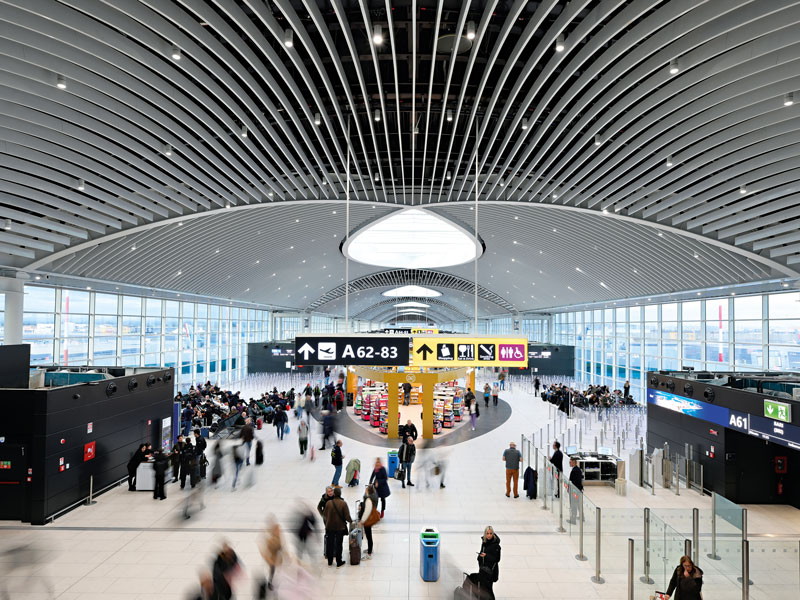
Decarbonisation remains at the forefront of the air transport sector, pivotal for both its development and survival. Sustainable finance plays a key role in aligning the industry’s strategies with environmental and social responsibilities. Aeroporti di Roma (ADR) is championing sustainability initiatives, setting ambitious goals for higher levels of environmental responsibility. The company is leveraging cutting-edge financial instruments like sustainability-linked bonds to drive its decarbonisation targets and advance innovative solutions for low-emission aviation.
Sustainable finance at ADR
ADR’s commitment to environmental and social responsibility is reflected in its innovative financial approaches, including the issuance of sustainability-linked bonds, which connect the cost of debt to its environmental performance, incentivising the company to achieve its decarbonisation goals. ADR was the first airport operator in the world to issue a sustainability-linked bond in 2021. Unlike a green bond, which is used to finance specific sustainable projects (and which ADR used in 2020), the interest rates paid to investors are linked to the company’s sustainability goals.

For example, in July 2023, ADR issued another 10-year bond (€400m, 4.875 percent coupon) tied to its targets for cutting Scope 1 and 2 emissions to net-zero by 2030 through initiatives such as new photovoltaic plants, electrifying its vehicle fleet, and using biofuels. For Scope 3, the goal is a 30 percent reduction by 2030 (from 2019) in CO2 emissions per passenger transiting through the airport.
Up until April 2024, ADR’s financing structure is composed of 65 percent sustainability-linked financing instruments of different natures, spanning from a green bond, two sustainability-linked bonds and a sustainability-linked revolving credit line. All financing instruments initiated since November 2020 have been structured in ‘green’ or ‘sustainability-linked’ formats. The goal is to continue on this path.
Furthermore, ADR has established itself as a leader in sustainable finance and plays a pivotal role in the World Economic Forum’s (WEF) ‘Airports of Tomorrow’ initiative. As a corporate champion in this initiative, ADR, together with its parent company Mundys, is leading the finance pillar to advance low-carbon aviation. This initiative, co-led by the WEF and Airports Council International (ACI), aims to address the energy, infrastructure, and financing needs of the aviation industry as it transitions to net-zero carbon emissions by 2050.
The EU taxonomy
ADR’s sustainability performance is also reflected in its alignment with the European taxonomy. ADR welcomes the introduction of the EU taxonomy, a science-based classification system to identify economic activities on the basis of their contribution to environmental sustainability objectives. By channelling private investment into the transition to a climate-neutral, climate-resilient, resource-efficient and fair economy, this system sits at the core of the EU’s world-leading sustainable finance agenda, with the additional goal of avoiding greenwashing practices.
Aeroporti di Roma has established itself as a leader in sustainable finance
ADR has always actively participated in institutional dialogue with the EU Commission and its technical bodies to promote and develop the EU taxonomy and its applicability to transport infrastructure, in order to facilitate its enabling role to the net zero 2050 transition. ADR also collaborated intensively with ACI Europe, in shaping guidelines for the airport sector to apply the EU taxonomy.
In 2023, with 75 percent of its revenues, 81 percent of its investments, and 65 percent of its operating expenses aligned with the EU taxonomy, ADR stood out among its peers for its adherence to this scheme. The EU taxonomy serves as a beacon for ADR’s sustainability strategy, guiding its references and best practices, and influencing its role in financial markets. Such KPIs were possible for a variety of reasons, all linked to ADR’s sustainability efforts. Some examples are:
The energy efficiency of our buildings and terminal. Apart from being certified to the highest standards in sustainability, such as LEED and BREEAM certifications, the terminal of Rome Fiumicino sits among the top 15 percent of the most energy-efficient buildings in Italy.
The provisions of electrical power and preconditioned air to airplanes. Thanks to this equipment, which is present in almost all parking stands in Rome Fiumicino, airplanes can avoid using their APUs, avoiding harmful emissions.
The installation of electrical charging points for vehicles. In fact, ADR has a plan to install more than 5,000 recharging points throughout its airports.
EU taxonomy is not only a ‘reporting tool,’ but it is also a way to drive change inside an organisation. Taxonomy has been and will be more and more helpful in driving sustainable change in ADR, especially regarding actions to foster climate change mitigation and adaptation. In this regard, to tackle climate change risks and opportunities, Aeroporti di Roma has developed a sophisticated ‘climate change risk analysis’ aligned with international standards and methodologies, such as ICAO guidelines and ISO 14091.
Aeroporti di Roma integrates this comprehensive analysis into its enterprise risk model (ERM), enabling it to manage climate risks with a long-term perspective. This approach includes advanced climate modelling, resilience assessment, and strategic adaptation planning, aligned with the European taxonomy for sustainable investments.
The pursuit of sustainable finance in the aviation sector is crucial for building a green future. ADR, through its pioneering initiatives and alignment with international sustainability standards, demonstrates how airports can lead in environmental and social responsibility. ADR’s innovative use of sustainability-linked bonds and alignment with the European taxonomy showcase its commitment to decarbonisation and sustainable development, setting a benchmark for the industry.


